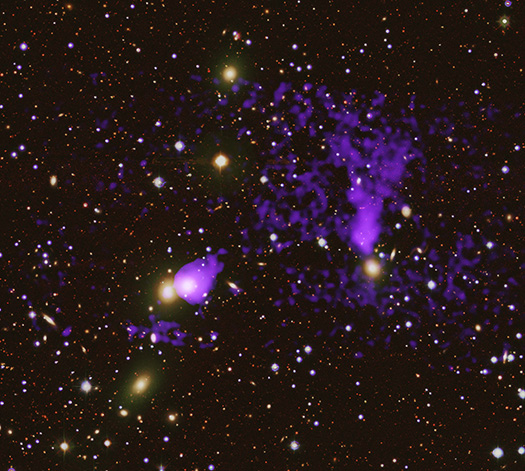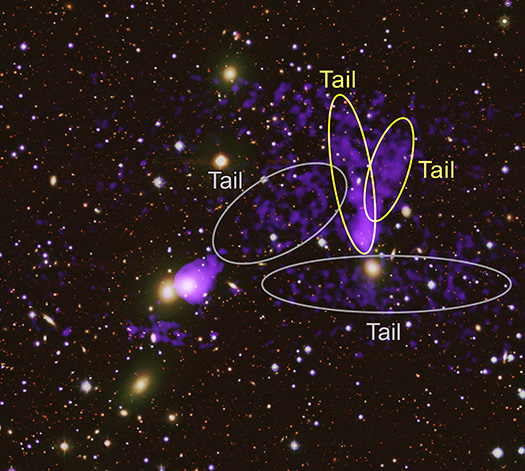NASA's Chandra Finds Galaxy Cluster That Crosses the Streams

Zwicky 8338
Credit: X-ray: NASA/CXC/Xiamen Univ./C. Ge; Optical: DESI collaboration; Image Processing: NASA/CXC/SAO/N. Wolk
Astronomers using NASA’s Chandra X-ray Observatory have found a galaxy cluster has two streams of superheated gas crossing one another. This result shows that crossing the streams may lead to the creation of new structure.
Researchers have discovered an enormous, comet-like tail of hot gas — spanning over 1.6 million light-years long — trailing behind a galaxy within the galaxy cluster called Zwicky 8338 (Z8338 for short). This tail, spawned as the galaxy had some of its gas stripped off by the hot gas it is hurtling through, has split into two streams.
This is the second pair of tails trailing behind a galaxy in this system. Previously, astronomers discovered a shorter pair of tails from a different galaxy near this latest one. This newer and longer set of tails was only seen because of a deeper observation with Chandra that revealed the fainter X-rays.

Astronomers now have evidence that these streams trailing behind the speeding galaxies have crossed one another. Z8338 is a chaotic landscape of galaxies, superheated gas, and shock waves (akin to sonic booms created by supersonic jets) in one relatively small region of space. These galaxies are in motion because they were part of two galaxy clusters that collided with each other to create Z8338.
This new composite image shows this spectacle. X-rays from Chandra (represented in purple) outline the multimillion-degree gas that outweighs all of the galaxies in the cluster. The Chandra data also shows where this gas has been jettisoned behind the moving galaxies. Meanwhile an optical image from the Dark Energy Survey from the Cerro Tololo Inter-American Observatory in Chile shows the individual galaxies peppered throughout the same field of view.
The original gas tail discovered in Z8338 is about 800,000 light-years long and is seen as vertical in this image (see the labeled version). The researchers think the gas in this tail is being stripped away from a large galaxy as it travels through the galaxy cluster. The head of the tail is a cloud of relatively cool gas about 100,000 light-years away from the galaxy it was stripped from. This tail is also separated into two parts.
The team proposes that the detachment of the tail from the large galaxy may have been caused by the passage of the other, longer tail. Under this scenario, the tail detached from the galaxy because of the crossing of the streams.
The results give useful information about the detachment and destruction of clouds of cooler gas like those seen in the head of the detached tail. This work shows that the cloud can survive for at least 30 million years after it is detached. During that time, a new generation of stars and planets may form within it.
The Z8338 galaxy cluster and its jumble of galactic streams are located about 670 million light-years from Earth. A paper describing these results appeared in the Aug. 8, 2023, issue of the Monthly Notices of the Royal Astronomical Society and is available online at: https://academic.oup.com/mnras/article/525/1/1365/7239302.
NASA's Marshall Space Flight Center manages the Chandra program. The Smithsonian Astrophysical Observatory's Chandra X-ray Center controls science operations from Cambridge, Massachusetts, and flight operations from Burlington, Massachusetts.
- Log in to post comments
